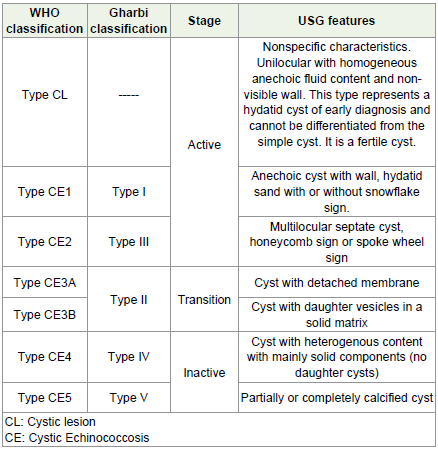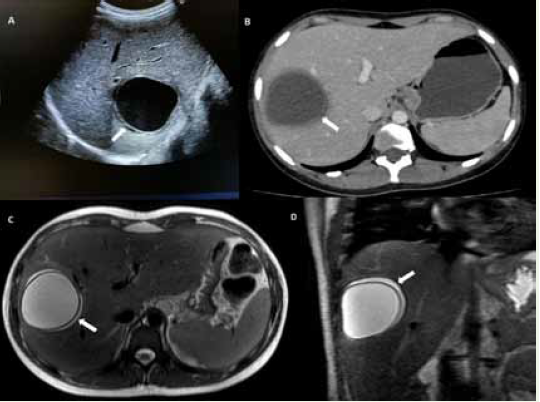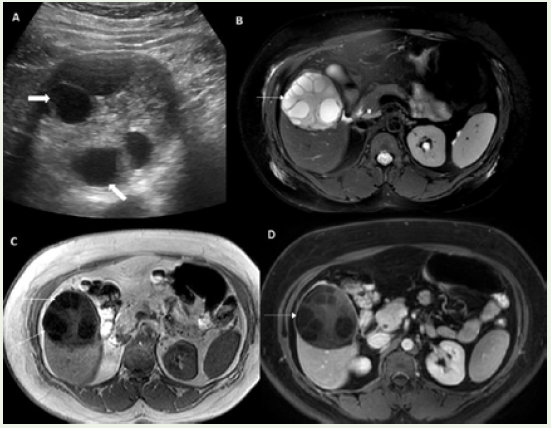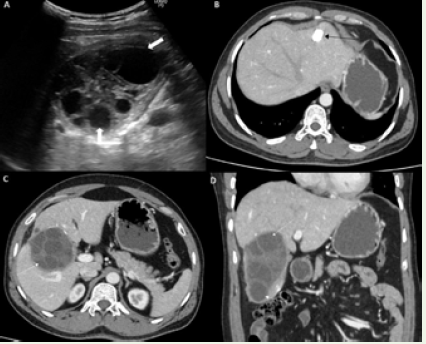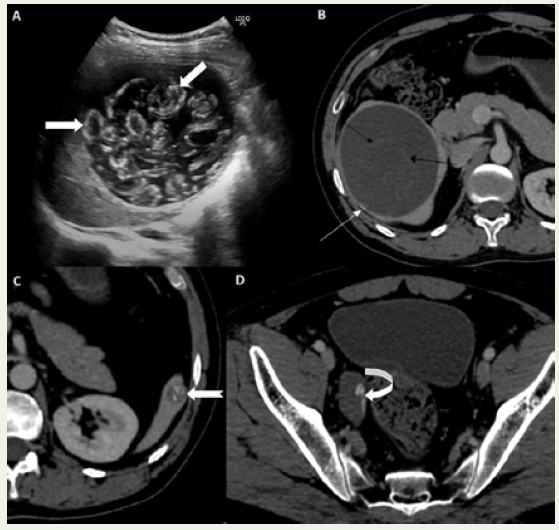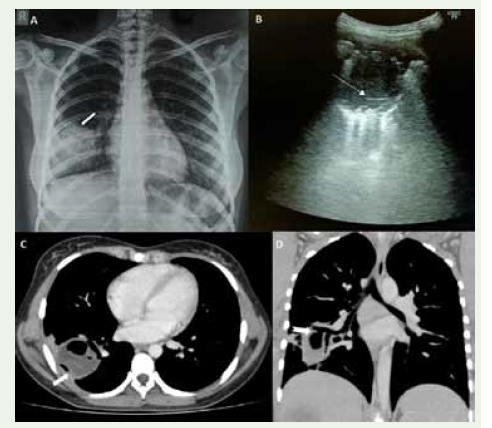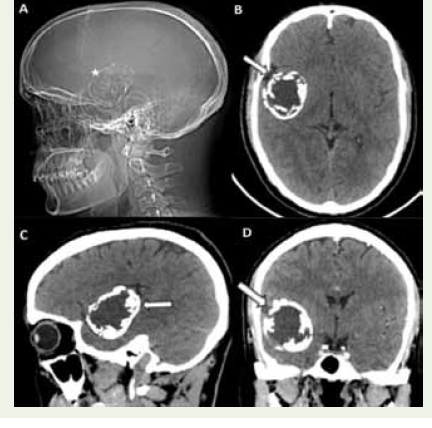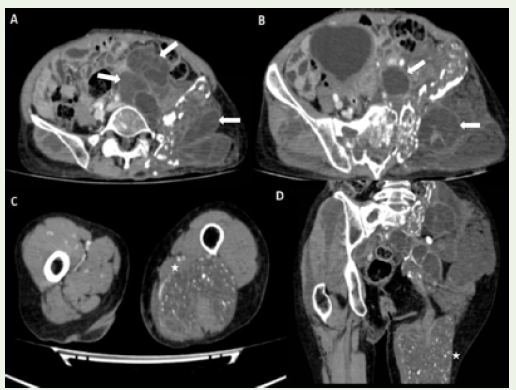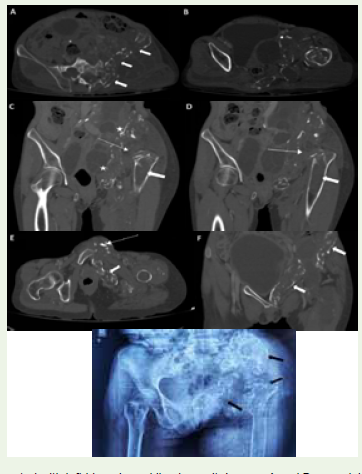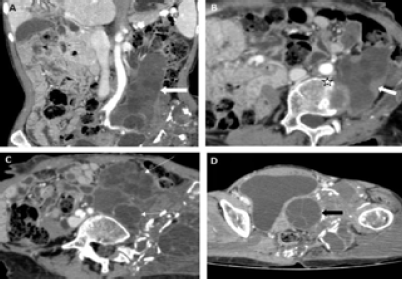Pictorial Essay
Unveiling the Enigma: A Pictorial Review of Imaging Features in Hepatic and Extra-Hepatic Hydatid Disease
Mahajan N*, Sankhe-Sonve A and Patil S
Department of Radiology, LTMMC and LTMGH, Sion, Mumbai , India
*Corresponding author:Nikhil Mahajan, Resident, Department of Radiology, LTMMC and LTMGH, Sion, Mumbai, India. E-mail Id: nikhil697@gmail.com
Copyright: ©2024 Mahajan N, et al. This is an open access article distributed under the Creative Commons Attribution License, which permits unrestricted use, distribution, and reproduction in any medium, provided the original work is properly cited.
Article Information:Submission: 25/04/2024; Accepted: 08/07/2024; Published: 12/07/2024
Abstract
Hydatid disease is a zoonotic infection that is endemic in many parts of the world, mainly caused by the parasite Echinococcus granulosus, which primarily affects the liver and shows characteristic imaging features. However, hydatid disease is known to affect other organs, including spleen, kidney, lungs, heart,
peritoneum, muscles, and brain. Laboratory serological findings and radiological features usually help establish the diagnosis of hydatid disease, however, hydatid cysts in unusual locations with atypical imaging features may complicate the differential diagnosis. Chest radiography (CXR), ultrasonography (USG),
computed tomography (CT), and Magnetic resonance (MR) imaging help in the detection of the hydatid cysts in the liver and elsewhere as the imaging features of hydatid disease in extrahepatic locations frequently imitate features of hepatic hydatid disease. We propose various cases of hydatid disease with
multiple locations.
Keywords:Hydatid; MRI; CT; Daughter Cysts; Gharbi
Introduction
Hydatid disease or echinococcosis, is a zoonotic infection caused
by the larval stage of the tapeworm from genus Echinococcus. Among
the various species included under this genus, those of medical
importance are E. granulosus and E. multilocularis, associated with
cystic echinococcosis and alveolar echinococcosis among humans.
Radiological imaging plays a critical role in the diagnosis and
management of hydatid disease, providing valuable information for
the accurate characterization and localization of cystic lesions.
Hydatid cysts can affect the liver, lungs, brain, heart, kidneys,
spleen, bones, and soft tissues, each presenting with unique
radiological features. Ultrasonography is the primary imaging
modality for initial evaluation, offering a cost-effective and widely
available method for assessing hydatid cysts’ morphology and content
[1]. Computed tomography (CT) is essential for providing precise
anatomical location and detecting specific features such as daughter
cysts, calcifications, and cyst wall thickness [2]. Magnetic resonance
imaging (MRI) helps better soft tissue characterization, aiding in
assessing complex hydatid cysts in various anatomical locations. This
pictorial essay and literature review will highlight the key imaging
features for the diagnosis of hydatid disease.
The hydatid cyst consists of three layers
• Pericyst: an outer fibrous capsule
•Ectocyst: an intermediate layer, made of acellular chitinous, laminated hyaline material
• Endocyst: The vital inner germinal layer giving rise to brood capsules and protoscolices.
• Pericyst: an outer fibrous capsule
•Ectocyst: an intermediate layer, made of acellular chitinous, laminated hyaline material
• Endocyst: The vital inner germinal layer giving rise to brood capsules and protoscolices.
Classification:
The Pan American Health Organization (PAHO) and the WHO
support the Gharbi’s and the WHO’s classification for diagnostic
imaging, as explained briefly in [Table 1] [3].Liver:
Liver hydatid cysts can be solitary or multiple. On ultra
sonography, hydatid cysts exhibit a “snowstorm sign “characterized
by numerous echogenic foci that fall into the dependent portion of the
cyst [Figure 5], which helps distinguish it from a true hepatic cyst [2]. On diffusion-weighted MR imaging, hydatid cysts have higher signal
intensity than the liver parenchyma on high-b-value images and ahigher cyst-to-liver intensity ratio [4].On USG, the cyst wall usually
manifests as double echogenic lines separated by a hypoechogenic
layer [1] (Figure 2).
The common complication observed with hepatic hydatid cysts is
rupture and secondary infection. There are three types of cyst rupture,
contained, communicating, and direct. In contained ruptures, the
endocyst breaks, with collapse and wrinkling of the germinative
membrane within the cyst, but the pericyst remains intact [5].The
typical imaging signs suggestive of contained rupture include the
“waterlily sign, “snake/serpent sign”, or the “snowstorm pattern” due
to detached undulating membranes within the cyst that appear on
ultrasound, CT, and MRI as serpentine floating linear membranes
within the cyst [6].A combination of hydatid sand and detached
membranes manifested as a mixed echogenicity solid-appearing
lesion on USG can represent a “Ball of Wool sign”[Figure 5] that can
be distinguished from a solid tumor by Doppler ultrasound [7].
Communicating rupture indicates the passage of the cyst
contents into the biliary radicles that have been incorporated
into the pericyst [1]. The definitive sign of rupture into the biliary
tree is the visualization of the cyst wall defect or communication
between the cyst and a biliary radicle [8]. Hydatid cyst content into
the biliary tract is noted as high attenuation/intensity content in the
common bile duct on CT and T1-weighted MR imaging and as a
hypointense filling defect on T2-weighted MR imaging or magnetic
resonance cholangiopancreatography [6]. On MR imaging, using a
hepatobiliary-specific contrast agent, a direct fistulous track could be
noted between the hepatic hydatid cyst and biliary tree with leakage
of the hepatobiliary contrast agent from the biliary tree into the
hepatic hydatid cyst [9,10]. The presence of intra-cystic fat due to the
lipid content of the bile or air content and air-fluid levels are indirect
signs of communicating rupture on CT and MRI [6]. Rupture of both
pericyst and endocyst results in direct rupture with free spillage of
hydatid material into the peritoneal cavity, pleural cavity, and so on
[8].
Contrast-enhanced CT is the modality of choice for cyst infection
which demonstrates poorly defined masses with typical high attenuation
rim representing abscesses surrounding the lesion [1,11].
Hydatid cysts may progress beyond the boundaries of the liver
via natural routes, most commonly the bare area of the liver and the
Figure 1:Case of a 60-year-old female with right hypochondriac pain: Axial sections of non-contrast (Image A), contrast (Image B), and delayed phase (Image C) of CT abdomen respectively reveal a well-defined solid lesion in the right lobe of liver showing areas of calcification (hyperdense areas within cyst) and
hypodense membranes (marked by white block arrow), with no enhancement and washout on contrast and delayed phase (WHO stage CE-4 or Gharbi type IV).
Figure 2: Case of a 19-year-old female with right hypochondriac pain: Ultrasound image of the liver (Image A) shows an anechoic doublewalled cystic lesion – ‘Double line sign’ (marked by white block arrow). Image B is the axial section of the contrast-enhanced CT abdomen of the same patient showing a rounded well-defined non-enhancing hypodense double-walled cystic lesion (marked by a white arrow). Axial (Image C) and coronal sections (Image D) of the T2-weighted MR sequence reveal a similar double-walled (marked by a white arrow) hyperintense cystic lesion in the right lobe of liver.
Figure 3:Case of a 37-year-old female with fever: Image A is an ultrasound image of the liver showing a well-defined hyperechoic lesion with few anechoic cystic lesions (marked by white block arrow), suggestive of daughter cysts (WHO stage CE-3B or Gharbi type II). Axial sections of T2-weighted (Image B), T1-weighted (Image C), and T1-weighted post-contrast (Image D) sequences of the same patient
reveal a multivesicular, well-defined peripherally enhancing partially exophytic lesion with daughter cysts (marked by white line arrow).
Figure 4:Case of a 56-year-old female with abdominal pain: T1-weighted axial section (Image A) and T2-weighted coronal (Image B) and axial (Image C) section respectively of MRI abdomen reveals a well-defined partially exophytic well-defined T1-hypointense and T2-hyperintense lesion showing few T2 hypointense septae (marked by white line arrow) within (WHO stage CE-2 or Gharbi type III).
Figure 5:Case of a 15-year-old male with right hypochondriac pain: Image A is an ultrasound image of the liver showing a heterogenous lesion with few hypoechoic detached irregular laminated membranes(marked by white block arrow) with hyperechoic matrix– ‘Ball of Wool sign’ suggestive of WHO stage CE-4 or Gharbi type IV. The axial non-contrast section (Image B) of the CT abdomen in the same patient reveals a well-defined hypodense lesion with internal linear calcification within (marked by white line arrow). Image C is a T2-weighted axial section of an MRI abdomen showing a well-defined T2 hyperintense cystic lesion in the liver with a T2 hypointense area (marked by a white line arrow) and few T2 hypointense thin septations (marked by white block arrow) suggestive of detached membranes.
gastrohepatic ligament.Trans-diaphragmatic migration manifests
variedly ranging from simple adherence of the cyst to the diaphragm
to more severe complications like rupture into the pleural cavity,
seeding in the pulmonary parenchyma, and chronic bronchial fistula
[1].
Lung:
The second most commonly involved organ is the lung which
shows spread by hematogenous mode in adults and is probably the
most common organ in children [2]. Most cysts are acquired in
childhood, remain asymptomatic for a long period, and are usually
diagnosed incidentally on chest radiography [1]. Calcification in
pulmonary cysts is very rare (0.7% of cases), although it may be seen
in pericardial, pleural, and mediastinal cysts [1].Giant pulmonary hydatid cysts are common in pediatric patients
due to their expeditious growth in childhood attributed to the lung
tissue and immune system of the host [2]. A unique feature associated
with pulmonary hydatid cysts is their change in shape with respiration.
The imaging findings vary with the stage of parasitic growth and its
relationship with the lung tissue.
Chest radiography is the initial imaging modality to examine
patients with pleuropulmonary hydatid disease [7] (Figure 10).The
uncomplicated cysts appear as well-defined homogenous radioopacity
on chest X-ray (Figure 10). The loss of a spherical shape on
an X-ray with the appearance of a small depression (resulting in a
reniform shape) may imply bronchial rupture and has been referred
to as the “slot sign” [12].CT is quite effective for visualization of
collapsed cyst membranes and daughter cysts as well as chest wall
invasion or pleural extension by the cysts.
The growth of the cyst produces erosions in the bronchioles
that are included in the pericyst causing it to rupture resulting in
communication with the tracheobronchial tree, allowing air to enter
the potential space between the pericyst and the ectocyst giving rise
to the “meniscus sign” [2]. When communication develops between
the tracheobronchial tree and the endocyst, air enters between the
endocyst and the pericyst which appears as a radiolucent rim around
the cyst known as the “air crescent sign”[12] (Figure 10). The “Cumbo
sign” and “double arch sign” are noted with the introduction of more
air in the endocyst forming an air-fluid level with accompanying
surrounding pulmonary consolidation which indicates expelled cyst
fluid. If air continues to enter the cyst cavity, the two layers separate
from each other with the collapsed and crumpled endocyst floating
freely in the most dependent part of the pericyst cavity known as the
“water lily sign” or the “camolette sign”[12] [Figure 10].After the
expectoration of cyst fluid, hyperattenuating collapsed membranes
can be seen within the dependent part of the cyst, known as the “whirl
sign” or “serpent sign”.After the complete expectoration of the cyst
fluid and membranes, the cyst appears only air-filled, known as the
“Dry cyst sign”[13].
Brain:
Hydatid cyst of the brain is an extremely rare entity, more
commonly diagnosed in children. Usually solitary, the hydatid
cysts can occur anywhere within the brain, with supratentorial
predominance, commonly involving the parietal lobe, especially
along the territory of the middle meningeal artery [2].A well-defined spherical or oval homogeneous cystic lesion with a
thin wall and smooth margins is noted on both CT and MRI imaging
modalities with imaging characteristics of the cystic component
similar to that of CSF [1]. T1 and T2-weighted MR imaging shows
a well-defined unilocular lesion with a CSF signal intensity that
does not show any diffusion restriction or perilesional edema [7].
The typical MR imaging feature for the pericyst is a hypointense rim
on T2-weighted images, however, a hyperintense halo may also be
encountered [7]. The presence of surrounding edema and peripheral
enhancement on MR imaging indicates either impending rupture or
infection.
Calcification is better evaluated on CT; however, it is an
uncommon finding for cerebral hydatid. Our case documented
calcification within the cerebral hydatid cyst [Figure 11].The most
important complications of cerebral hydatidosis are infection
and rupture of the cysts. Infected hydatid cysts show contrast
enhancement making differential diagnosis difficult [2].
MR imaging is a superior imaging modality to CT in the preoperative
evaluation of cerebral hydatid cysts [7]. Differential
diagnoses include arachnoid cysts, porencephalic cysts, epidermoid
tumors, pyogenic abscesses, and cystic tumors of the brain.Common
complication includes intracerebral rupture with a risk of seedling
resulting in local and spinal recurrence [14].
Muscle Involvement:
Intramuscular hydatid is a rare entity.The thigh and gluteal
region are the most common locations for subcutaneous hydatid
cysts [Figure 12], followed by the head and neck region.Ultrasonography is a crucial non-invasive technique for
confirming the diagnosis of hydatid disease, which shows distinctive
daughter cysts.The CT appearance of hydatid cysts may sometimes
resemble tumors when they present as solid masses, however,
diagnosis can be confirmed by the presence of daughter cysts or
calcifications within the cyst wall [15] [Figure 12].
MRI is an important imaging modality in diagnosing and
evaluating the extent of skeletal muscle infestation. In the muscles,
the cysts typically show multiple vesicles within the mother cyst,
secondary to the endogenous proliferation of the germinal layer
referred to as a “cyst or cysts within a cyst”[15].These cysts show a
hypointense signal as compared to that of the intra-cystic fluid on T1
and low or high signal intensity on T2-weighted images [15] [Figure 13]. A low-signal intensity rim is evident on T2 weighted MR images,
referred to as the rim sign, which can be a valuable MRI finding in the
diagnosis of muscular hydatidosis and helps to differentiate it from
other cystic lesions or tumors in the muscles.
Skeletal Involvement:
Bone involvement is one of the rare manifestations of hydatid
disease, often misdiagnosed on initial radiological evaluation.The
absence of pericyst formation is a defining characteristic of bone
hydatid cysts, resulting in the lack of peripheral capsular calcifications,
causing an aggressive proliferation in an irregular branching pattern,
thus eventually the parasite infiltrates the osseous tissue and erodes
the cortex [2].Radiographs usually reveal a well-defined multi-loculated
osteolytic lesion, accompanied by bone expansion, thinning of
the cortical bone, and extension into the surrounding soft tissues
[7] [Figure 14]. Computed tomography (CT) imaging provides
improved visualization of lytic lesions, allowing for the distinction
between unilocular and multilocular lesions and identifying any
extensions into soft tissues [16] [Figure 14]. In cases where they exist, characteristic mother and daughter cysts may be observed, resulting
in a visual appearance resembling a “rosette” or “spoke wheel” [16].
Parasitized bone has varying signal intensity on T1-weighted MR
images, ranging from medium to low, and high signal intensity on
T2-weighted images.
Extraosseous HCs have the potential to undergo calcification [Figure 12,14], while calcification is uncommon in intraosseous HCs.
Spinal HD is the most common site of bony involvement, most
commonly involving the thoracic spine [16]. It can be intramedullary,
intradural extramedullary, extradural intraspinal, vertebral, or
paravertebral in location [16]. The spine is primarily infested through
porto-vertebral shunts, with the centre of the vertebral body being
the initial site of involvement. Spinal hydatid disease may mimic
tuberculous spondylitis or chronic osteomyelitis [2].
Typical imaging characteristics of spinal HD include the absence
of osteoporosis or sclerosis in the affected bone, no involvement of
the intervertebral disk space, and the presence of a subperiosteal,
subligamentous, or paraspinal extension of the disease [17].
Intraperitoneal and Retroperitoneal Involvement:
Peritoneal hydatidosis always occurs secondary to hepatic disease,
though some unusual cases of primary peritoneal involvement have
been described [18]. Most of the cases are related to previous surgery
for hepatic disease, although spontaneous, asymptomatic microruptures
of hepatic cysts into the peritoneal cavity are not uncommon
(12% of cases) [18].Ultrasound is the first line of investigation for the demonstration
of cystic membranes, septa, and hydatid sand; however, CT is
Figure 6:Case of a 45-year-old patient: Coronal MPR reconstruction of non-contrast (Image A) and contrast phase (Image B) of CT abdomen reveals a well-defined mixed density lesion in the liver showing multiple non-enhancing hypodense detached laminated membranes (marked by white block arrow) with calcified matrix (hyperdense areas on non-contrast phase)- WHO stage CE-4 or Gharbi type IV. Image C is the axial contrast phase section of the CT abdomen showing similar findings.
Figure 7:Case of a 66-year-old male patient with pain in the abdomen: Axial (image A) and its coronal MPR reconstructed sections (Image B) reveal a well defined hypodense lesion in the right lobe of liver with peripheral calcifications, not showing enhancement on contrast phase (Image C) – WHO stage CE-5 or Gharbi type V lesion. Note should be made of a few dots of calcification at the periphery of the lesion corresponding to scolices or daughter cysts (marked by a white line arrow).
Figure 8:Case of a 38-year-old male patient with right hypochondriacal pain: Image A is an ultrasound image of the liver showing a well-defined hyperechoic lesion with few anechoic cystic lesions (marked by white block arrow), indicative of daughter cysts. This was confirmed on contrast-enhanced CT abdomen axial (Image C) and coronal (Image D) MPR reconstructed sections that revealed a well-defined, lobulated, multiloculated, multi-cystic lesion with septations within and few areas of peripheral calcifications, suggestive of hydatid cyst (WHO stage CE-3B or Gharbi type II). Image B shows a completely calcified lesion (marked by a black line arrow) suggestive of a calcified hydatid cyst (WHO stage CE-5 or Gharbi stage V)
Figure 9:Case of a 40-year-old male patient with pain in the abdomen and fever: Image A is an abdomen ultrasound of the right hypochondriac region showing a cystic lesion with multiple hyperechoic detached laminated membranes within (marked by white block arrow). Image B is an axial section of the contrast-enhanced CT (CECT) abdomen that reveals a well-defined thin-walled hypodense
cystic lesion in the liver showing mildly hyperdense floating membranes (marked by black line arrow) within and a foci of wall calcification (marked by white line arrow) suggestive of “Water lily sign” - (WHO stage CE-3A or Gharbi type II). Image C is an axial section of the CECT abdomen showing a well-defined thin-walled cystic lesion with multiple calcific foci within (marked by a white notched arrow), suggestive of splenic hydatid cyst. Image D is an axial section of the CECT abdomen at the bladder that reveals a well-defined thin-walled hypodense cystic lesion with foci of calcification (marked by white curved arrow) in the pelvis on the right side posterior to the bladder, suggestive of pelvic peritoneal hydatid.
Figure 10:Case of a 60-year-old female with cough for 2 months: Contrast-enhanced computed tomography axial section (Image B), and coronal (Image A) and sagittal (Image C) MPR reconstruction reveals a well-defined peripherally enhancing thick-walled cavity with multiple non-enhancing cystic locules with few hyperdense septae/membranes (marked by white block arrow) within.
Figure 11: Case of a 20-year-old female with cough and hemoptysis: Image A is a frontal chest radiography showing a well-defined rounded radio-opacity in the right lower lung zone making an acute angle with the lung. Note should be made of air crescent sign (marked by white block arrow with black margin). Image B is a chest ultrasound showing a hypoechoic cystic lesion in the right lower lung lobe with an undulating membrane (marked by a white line arrow). Axial computed tomography section (Image C) reveals a well-defined peripherally enhancing hypodense cavitary lesion showing fluid and few air pockets within with hyperdense undulating floating membrane (marked by white block arrow) – ‘Water lily sign’. Image D is a coronal MPR reconstruction of the CT chest showing a basal segment bronchus communicating with the cavitary lesion (marked by a white notched arrow) giving rise to a Broncho-cavitary fistula.
Figure 12:Case of a 36-year-old male with weakness on the left side of the body. Image A is a lateral skull radiograph showing a well-defined radio-opaque (calcified) intracranial lesion (marked by a white star). Computed tomography axial section (Image B) with sagittal (Image C) and coronal (Image D) MPR reconstruction of the brain in soft tissue window reveals a well-circumscribed calcified mass in the anterior temporal region with peripheral arch-like calcification (marked by white arrow).
Figure 13: Case of a 60-year-old female with pain in the left lumbar and iliac region: Contrast-enhanced computed tomography axial sections (Image A and B) of the abdomen reveal multiple multi-loculated peripherally enhancing lesions at various stages (marked by white block arrows) noted in bilateral gluteus maximus, left gluteus medius and minimus, left pyriformis and iliacus muscle and left obturator externus. Image C is an axial section of contrast-enhanced CT at the level of the proximal femur and Image D is a coronal MPR reconstruction of contrast-enhanced CT at the level of the pelvis and upper thigh of the same patient showing multiloculated cystic lesions with few septations and multiple tiny punctate foci of calcification (marked by white stars) in the left adductor and hamstring muscles.
Figure 14:Case of a 21-year-old female with swelling in her lower back and history of dog feces exposure: T1-weighted (Image A) and T2-weighted (Image B) sagittal sections with STIR coronal (Image C) image of MRI lumbar spine reveal multilocular, encapsulated T1 hypointense and T2/STIR hyperintense cystic lesions with regular borders in left paraspinal muscles. Axial sections of T1-weighted and T2-weighted sections (Image D and E respectively) and T2-weighted FATSAT image (Image F) show similar findings.
Figure 15: Case of a 52-year-old female presented with left hip pain and limping gait: Images A and B are axial sections of CT abdomen in the bone window showing extensive osteolytic expansile destruction with multiple cortical breaks (marked by white block arrow) and multiple calcific foci in left iliac bone with bony resorption of acetabulum. Coronal MPR reconstruction (Images C and D) of CT pelvis in the bone window of the same patient shows resorption of the left femoral head and superior dislocation of the left proximal femoral (marked by white line arrows) and osteolytic destruction of left iliac bone (marked by
white stars). Images C and D also reveal a marrow-replacing lesion in the proximal femoral epiphysis and diaphysis (marked by a white block arrow). Image E is an axial image and Image F is a coronal MPR reconstructed image of the CT pelvis in the bone window that reveals extra-osseous extension of the lesion
beyond the pubic rami into the left labia majora where it shows calcification within (marked by white line arrow) and osteolytic destruction (marked by white block arrow). Image G is an Xray pelvis AP view of the patient showing osteolytic destruction of the left half of the pubic bone and left head, neck, and proximal
shaft of the humerus (marked by black block arrow) with multiple tiny foci of calcification within the left thigh muscles (marked by black line arrow) indicating muscle involvement.
Figure 16:Case of a 52-year-old female diagnosed with disseminated hydatid disease: Axial (Image A) and coronal (Image B) MPR reconstructed images of the venous phase of contrast-enhanced CT abdomen reveal multiple multiloculated varying stages lesions in the retroperitoneum and peritoneal cavity in the left paravertebral region involving left iliopsoas and left quadratus lumborum (marked by white block arrows). Images C and D are axial contrast phase sections of CT abdomen showing multiple multi-loculated varying stage lesions in the left presacral (marked by white line arrow), left peri-vesical (marked by black
arrow), and left lumbar region. In Image B, the multiloculated lesion in the left paravertebral region shows osteolytic destruction of the corresponding vertebra (marked by a white star), but no spinal canal involvement.
Figure 17:Case of a 24-year-old patient with diagnosed hepatic hydatid disease with incidentally detected pelvic hydatid: Image A is an ultrasound of the pelvis showing a heterogeneously hyperechoic lesion (marked by a white star) with few hypoechogenic laminated membranes within it in the post-vesical region. Coronal MPR reconstructed image (Image B) of non-contrast CT pelvis reveals a well-defined hypodense lesion (marked by black block arrow) with multiple thin internal septations/membranes (marked by black line arrow). Images C and D are T2-weighted axial and sagittal sections of MRI abdomen respectively showing a T2 hyperintense lesion (marked by white block arrow) in the post-vesical region with multiple T2 hypointense septations (marked by white line arrow) within representing crumpled membranes.
the modality of choice in peritoneal seedlings because of better
delineation of the extent of disease, cyst wall calcifications, and
rupture [18] [Figure 15,16]. Peritoneal hydatidosis shows imaging features similar to those seen in hydatid disease of other abdominal
viscera [7].Peritoneal hydatid disease may grow and occupy the entire
peritoneal cavity, mimicking a multiloculated mass, referred to as an
“Encysted Peritoneal Hydatidosis” [1].
The differential diagnosis of peritoneal hydatid disease includes
duplication cysts, mesenteric cysts, intraperitoneal abscesses,
pancreatic pseudocysts, cystic or myxoid sarcomas, large cystic
ovarian tumors, and gossypiboma [7].
Peritoneal dissemination may lead to the implantation of hydatid
scolices in several abdominal organs, referred to as “Metastatic
hydatidosis”[19]. It may manifest dramatically as a life-threatening
condition with anaphylactic shock or acute abdomen due to
chemically induced peritonitis [19]. Cysts in this region can grow to
enormous sizes spanning craniocaudally along the iliopsoas muscle
extending to the extraperitoneal pelvic compartment and may reach
up to the inguinal canal and proximal thigh [20].
Conclusion
Hydatid disease is endemic in many parts of the world. Though
commonly involves the liver, this parasitic disease can involve almost
any organ in our body. Familiarity with both, typical and atypical
features of hepatic and extra-hepatic hydatid disease on USG, CT,
and MRI can prove advantageous in making prompt diagnosis.

